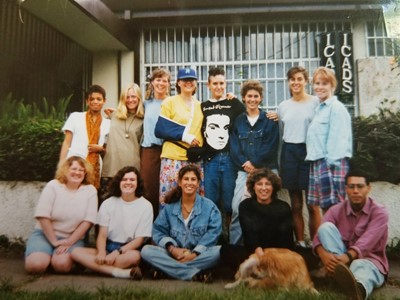Blog
Urban gardens in Curridabat A maternity leave mini-IP
By: Katherine Peters
January 01, 2017
While working at ICADS, I was always struck by the passion many students arrive with to their semester abroad. Topics they care about and learn about at home inspire them to compare and contrast with communities in Central America, in their quest for more justice and better sustainability. To that end, it seemed that nearly every semester at least one student would arrive to ICADS interested in urban gardens, hoping to carry out field research or an internship in an urban garden.
While this concept is not exactly the same in Costa Rica, a few organizations do exist that are working to promote urban agriculture, or agriculture anywhere. As one organization is called: Huertas donde sea (Gardens Anywhere). In my own neighborhood, there is Currihuertas (in Curridabat). Other groups, some more organized than others, exist throughout the country, joined by small farms that promote agriculture or farmers markets in the cities.
However, while walking my baby’s stroller around my neighborhood during my maternity leave (August – November, 2016), I was struck by the many gardens that exist all over the place, in empty lots. These gardens are different from the middle-class, “hippy”-feelings gardens of the organized efforts, like those linked above. Those gardens grow kale, or are arranged to look like mandalas, or have murals painted next to them. The gardens I started noticing were different. They were full of hearty food: corn, beans, squash, bananas, papayas. Some were huge, with rows of corn and beans. Others were almost clandestine, with a patch of squash nearly hidden behind a ridge and under a cover of tall grass.
As I continued to walk (my, ahem, transects) and put my ICADS observational skills to work, I noticed that many of these heavy duty food gardens exist near the small guard houses that dot the middle class neighborhood where I live. I hypothesized that the largely Nicaraguan security guards were taking advantage of empty lots to plant food, probably in the same way they planted back home in their rural areas of Nicaragua. And I was struck that I could find out – I could interview them, ICADS-style.
I was hoping to write up a whole mini-IP to share with you on the blog, but I have found that taking care of my now 1-year old (!) and working on my master’s thesis has left me with precious little time. So, I’ll share my partial IP. One of you will have to do the full project.
Objectives
- Explore the urban gardening practice in Lomas de Ayarco Sur, Curridabat
- Determine the motivations for gardening
- Distinguish between different kinds of gardens
- Formulate questions for further study
Methods
During my maternity leave (October and November, 2016) I walked the streets of my neighborhood, Lomas de Ayarco Sur, in Curridabat, with my 2-3 month old baby (Matthew) in his stroller, observing the urban gardens: their locations and the crops planted there. I observed the location of guardhouses in relation to these gardens.
Matthew and I walked usually in the mid-morning hours, and over the course of several walks were able to cover all of the streets to the North and East of the Tirribí River as seen in Figure 1.
During our walks, we sought out guards that were available in their guardhouses in order to ask them about the gardens. These conversations were relatively informal, and depended on the presence of the guards. This was due to the fact that our walks were impacted by the needs of a 2-3 month old baby (sleeping and waking, hunger, diaper changes, etc). We were unable to talk with some guards, as they were never available in their guardhouses during our walks.
Results and Discussion
I found 10 urban gardens in my neighborhood, which are shown with green letters in Figure 1. I also found 19 guardhouses in the same area, shown with read numbers. As you can see, many gardens are found near guardhouses, though not all of them.
One of the gardens (A), is cared for by an organization called Currihuertas (link to their Facebook page, above). This garden is the most diverse, and includes a compost heap under a wooden structure, as well as a sign and barbed wire fence around it. All of the other gardens are less structured, and from my interviews I learned that they are all planted and maintained by the Nicaraguan security guards that work in the neighborhood.
I spoke with __ guards, all Nicaraguan men, with varying years of experience living in Costa Rica. All of them told me that they were farmers in Nicaragua, and many of them were eager to share with me information about planting and harvesting back home. For example, one started to explain how his family plants radishes in raised beds, and he even demonstrated how to tell the right time to plant and harvest by cutting a banana leaf and seeing if water comes out of the stem or not (this has to do with the moon cycle and the ocean’s tides – that’s worth another post). Some of the guards recently moved to Costa Rica, and were planning to move back home soon. Others have lived in Costa Rica for many years. All of them lived across the Tirribí river in the poor and overcrowded neighborhood of Tirrases, where they told me they do not have room to plant any crops.
I also spoke briefly with the young men who work the Currihuertas garden, who told me that they have been given permission by the landower, the woman who lives next door, to plant this garden. They also have another garden at the local public elementary school in Barrio La Lía.
One of the guards told me that they are given permission by the land owners to plant gardens on these empty lots, because the lots that are “cleaned” and used are considered safer from squatters. When asked why some empty lots near guardhouses have not been planted, he responded that those landowners did not grant the guards permission to plant there (“some people don’t like that”).
Figure 1. Map of guard houses and gardens, Lomas de Ayarco Sur, Curridabat

Table 1. List of gardens and crops as of October and November, 2017
|
Garden |
Crops |
|
A |
Kale, lettuce, tubers, corn, peppers, eggplant, broccoli, peppers, cabbage, herbs |
|
B |
Squash |
|
C |
Corn, cabbage, onion |
|
D |
Tubers |
|
E |
Squash, aloe |
|
F |
Squash |
|
G |
Banana, papaya, squash, corn, citrics |
|
H |
Herbs, bell peppers, flowers |
|
I |
Corn, squash |
Figure 2. Example of an urban garden next to a guardhouse in Lomas de Ayarco Sur
Biases and Limitations
My time was very limited in speaking with each guard, due to walking with a newborn in a stroller – thus each interview was non- to semi-structured, and not as long as I would have liked.
Conclusion
Urban gardens in Lomas de Ayarco Sur are largely serving two conscious purposes for the guards who tend them: food production for workers with low cash income, and cultural practice for Nicaraguan immigrants far from home.
An exception to this general rule is the Currihuertas garden, which does not represent the cultural practice of Nicaraguan immigrants (rather a project for young Costa Ricans interested in socio-environmental issues), and serves the alternative purpose of education for sustainability and organic agriculture.
Questions for further research
Many of the guards were very interested in sharing their life experience in agricultural and rural life in Nicaragua, and in demonstrating their agricultural knowledge. Further inquiry into the role that migration to urban areas in Costa Rica from rural areas in Nicaragua would strengthen both rural and urban sociological studies in the region. These studies could be related to income and food security, cultural identity, land tenure and use, and even relationships between the Nicaraguan guards and their Costa Rican employers.
Studies could be performed in the natural sciences regarding species diversity surrounding urban gardens in Curridabat (birds, insects, etc).
Figure 2. Example of an urban garden next to a guardhouse in Lomas de Ayarco Sur

Biases and Limitations
My time was very limited in speaking with each guard, due to walking with a newborn in a stroller – thus each interview was non- to semi-structured, and not as long as I would have liked.
Conclusion
Urban gardens in Lomas de Ayarco Sur are largely serving two conscious purposes for the guards who tend them: food production for workers with low cash income, and cultural practice for Nicaraguan immigrants far from home.
An exception to this general rule is the Currihuertas garden, which does not represent the cultural practice of Nicaraguan immigrants (rather a project for young Costa Ricans interested in socio-environmental issues), and serves the alternative purpose of education for sustainability and organic agriculture.
Questions for further research
Many of the guards were very interested in sharing their life experience in agricultural and rural life in Nicaragua, and in demonstrating their agricultural knowledge. Further inquiry into the role that migration to urban areas in Costa Rica from rural areas in Nicaragua would strengthen both rural and urban sociological studies in the region. These studies could be related to income and food security, cultural identity, land tenure and use, and even relationships between the Nicaraguan guards and their Costa Rican employers.
Studies could be performed in the natural sciences regarding species diversity surrounding urban gardens in Curridabat (birds, insects, etc).

ICADS Partner Spotlight: Celebrating 30 years with Pitzer College
ICADS and Pitzer College celebrate and reflect on 30 years of working together in Study Abroad!
#COSTA RICA #ICADS ACADEMIC #NEWS #STUDY ABROAD

Alumni Newsletter
A few weeks ago, ICADS received an email from an alumnus from 1993, which was only a few years into the existence of the program. Hearing a little about this once student's experience and how ICADS changed the trajectory of their life rang familiar to us here, and we hope to celebrate that legacy and the mission that enables it.
#CULTURE #INTERNSHIP #STUDY ABROAD

A Year in Review: Change and Adaptation in 2020
As we approach one year since the COVID-19 pandemic began, we reflect on a year of change and adaptation, and we look forward to a new chapter in 2021!
#COSTA RICA #STUDY ABROAD #ICADS ACADEMIC #NEWS